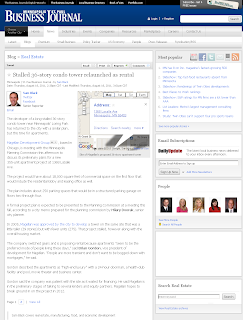I don't see glib excuses cutting it. But I guess I'm not as sharp as Colin McGlone says he is, because he sees no ugliness in Ramsey's ramp-wrap-rental bride. As beautiful as Ninety-7-Fifty is touted to become, I suppose. (This link, showing text dropped in Ramsey is not unique, the same bull having amazing mobility -and please, excuse me, it is: Ninety-7-Fifty, On the Park. Nothing pretentious. Just getting the name right.).
FLAHERTY-&-COLLINS: Should the firm be allowed to build again? One disenchanted buyer says no, emphatically - and there is more..
This link. This excerpt.
Matteson condos a bust[emphasis added, BNSF train pic. added]
From all outward appearances, the 50 units at the Echelon are very attractive condos in a convenient location. But after the first phase of Flaherty and Collins’ proposed 168-unit development was complete, the condo market tanked and only one-third of the units were built.
Current owners have a laundry list of issues that include leaking windows, leaking plumbing, mold, mismatched cabinets, buckling floors and no soundproofing. They also were promised a pool and clubhouse that never got built because not enough units were sold, they said.
Condo owner Nicole Taylor said the firm “should not be allowed to build again.”
But according to the Indianapolis journal, the 18-year-old company has a “sterling record.” It manages more than 12,000 apartment units and nearly two dozen projects in 10 states.
Still, Echelon resident Maxine Carr said every time it rains, water comes in her living room window, causing puddles on the window sill and wood laminate floor. She fears she will get mold, like another neighbor.
Carr filed an insurance claim for damages to the new unit she bought one year ago, but her insurance company denied it. She provided the letter from the insurance company saying water damage was due to “faulty workmanship to the flashing and the installation of the deck above” her unit.
When she called Flaherty and Collins, she said she was told her condo was no longer under warranty.
Carr said she may have to sue for repairs and damages.
Barb Hollivay, who purchased her unit three years ago, has a hole in her garage ceiling from her upstairs neighbor’s leaking bathroom.
Noise from adjoining units is so loud, “it feels like they are living in the house with me,” she said. “There is no privacy.”
Residents said they can literally hear every move their neighbors make. Sometimes they can even see what others are doing through the vents in the walls, Taylor said.
They said they complain at homeowners association meetings, to the property management company and to Flaherty and Collins but never get a response.
“People have just accepted it because they believe they can’t get anyone to hear them,” Hollivay said.
The Better Business Bureau reported that three complaints from Echelon owners were filed in 2008, 2009 and 2011, but all were resolved with the BBB’s assistance, according to its website.
Flaherty said he was not aware of any unresolved complaints in Matteson.
“Whenever we get a call, we fix what needs to be fixed,” he said. “This is news to me. We don’t run from problems.”
Nevertheless, the Orland Park project will be “totally different,” than Matteson, Flaherty said.
Matteson has “significantly different” building standards, and Echelon was designed as a low-cost project to make it attractive to buyers, he said.
The Echelon was his firm’s first venture into the condominium market, he said. The plan was to build 168 units, but after the first 50 were built, the market slowed down. Now, they are “waiting it out,” he said.
“They were wise not to finish building,” said Pam Hirth, Matteson’s director of community development. “We would not want them built and standing empty.”
More condo chaos
Another unsuccessful Flaherty and Collins condo project — 210 Trade in Charlotte, N.C. — was never built. Steel was erected two years ago over the lower-level retail shops, but that’s how it still stands today in Charlotte’s downtown area, said David Weekly, of Charlotte’s land-use department.
He said there were timing issues and legal issues with the building permit.
“We never abandoned that deal. It just didn’t make economic sense,” Flaherty said.
The market started going bad early in that process.
“It made no sense to build. Everyone would have lost more money,” he said.
That article leads as every article should, with a captioned photo:
Flaherty and Collins, the developer of the Echelon property in Matteson, has not completed the project or responded to resident complaints. | Larry Ruehl~Sun-Times Media
|
Readers in dear Ramsey can be excused for asking, "What's the story behind all this? How could that happen if this firm is as platinum plated as the town savants have been saying to us? Is there a disconnect somewhere from reality? Is the promising surrounding Flaherty-Collins spiels and deals - what - "suspect?"
The answer...
 |
| We're Apartment Guys ... |
______________UPDATE_____________
This is a good report, with numbers, bond rating talk, and an implication the Orland Park folks in office there are bigger risk takers than Ramsey's. They must have gone to Vegas too, and gotten the fever.
____________FURTHER UPDATE___________
It is good to read that some residents in Orland Park are not all willingly being a pack of sheep, although being shepherded, these article and comment excerpts from here:
Orland Park resident Janice Fleury questioned the comparisons made to a similar apartment complex in Indianapolis built by Flaherty and Collins, and whether the two locations themselves are similar enough to reasonably compare. The complex called Cosmopolitan on the Canal was built last year in downtown Indianapolis and has been fully rented out, Kirles said.
“Indianapolis isn’t a little suburb like we are,” Fleury said. “Everything comes down to dollars and cents, and we want to make sure this isn’t on our tax bill.“
Tom Cunningham then took the podium to ask why the apartment complex never went to referendum. [Village Trustee Ed] Schussler heatedly responded that there was no need to do so and “that’s why residents elected a mayor and trustees, to make these decisions.”
COMMENTS: Arthur Huff
11:52am on Tuesday, August 16, 2011
This just seems like a bad idea on so many levels. People talk about a potential burden on taxpayers but we have already started paying for this. Maybe not directly for bricks and mortar yet, but in lawyer fees, buying out successful businesses, and lost sales tax revenue when those places close, i.e Randy's Market. I can't deny that the plans for the development look nice. And if Orland would let it evolve naturally into that instead of trying to build a downtown atmosphere people would probably love it. And while Orland Park is trying to create something beautiful with the right hand it seems like they are hoping that nobody is paying attention to what they're doing with the left hand, and that is spending A LOT of money on a real estate investment opportunity. It wasn't too long ago that the articles in the paper were about increased fees (doubling vehicle stickers, increasing parking ticket fines to $60), people being laid off, and the Village bringing in consultants to trim the fat (unless of course the "fat" is related to someone high up in the Village). And once again I'll say, a 'bond sale' is government speak for BORROWING MONEY.
[emphasis added] That part about a referendum. They know in Orland Park a referendum would be defeated, as in Ramsey, where one would be resoundingly and definitively defeated. So they simply deny a public right to determine a very major shift in policy and modus operandi. That quote from the one trustee, “that’s why residents elected a mayor and trustees, to make these decisions.” Todd Cook used to like to say that sort of thing whenever citizens expressed vexation with bad decision making at the front council table. In fact, elections happen with the voter hope - usually against what history teaches - that the candidates ultimately elected will not produce a majority pack that once elected will circle the wagons against citizen criticism and pleas for caution and reason, and will instead make bone headed collective decisions because they spend almost all of their time talking to one another and reinforcing bad judgment that way, while debating critics instead of listening and reflecting long upon what the people talking about downside risk have to say. Then put a libertarian in among a pack of spendthrifts on a council and see what frustration can look like.
_____________FURTHER UPDATE_____________
What bothers me most when I hear that demand for "rental" is up, and that "rental" currently is the only healthy market segment with banks lending for "rental" but not for other real estate, is the unwillingness to consider transitory demand as an explanation. If you are a young couple or a single person with a downpayment amount stashed in some investment placement, or close to enough for a downpayment, would you buy now, in this market, putting the entire bundle at risk with prices still trending down? Of course not, you would hunker for a while tolerating shared-wall rental before plunging to get out to a single family detached home, with hopes of continuing future cash flow to make payments.
Strib recently reported:
Back-to-back housing reports show big price declines in Twin Cities
Posted by: Jim Buchta under Buying, Foreclosures Updated: August 31, 2011 - 3:58 PM
House prices in the Twin Cities metro area were down 7.3 percent in July compared with last year, according to a new report from CoreLogic Research. The July figures follow a 9.5 percent annual decline in prices from June 2011. And excluding distressed sales, year-over-year prices were down only 4.1 percent in July 2011.
The report follows the Case-Shiller report, which said Tuesday that house sale price declines in the Twin Cities during June were among the worst in the nation, but prices had risen month-to-month for three months in a row. The Case provides a local and national assessment of the market based on a large data set and always gets a lot of attention, but the methodology has also been debated.
Scott Sambucci, the chief operating officer of Altos Research, said that because there's a significant lag between when the sales happened and when the data is gathered and reported, the Case-Shiller data isn't the completely up-to-date. Case tracks sale prices on repeat sales to determine changes in pricing, but only includes single-family houses; townhoues and condos are excluded. Prices each month are based on a rolling three-month average.
To get a more accurate look at the market Altos tracks home list prices, the rationale being that if sellers see values rising, they're more likely to feel emboldened to increase their list price. In July, for example, Sabucci said that home list prices in the Twin Cities metro increased every month from April through June. In fact, the Twin Cities ranked among the top five of the 20 areas studied.
With uncertainty among professionals, and the enthusiasts predicting as they have for months that the market has finally bottomed out, people are suitably cautious. After all, it is their hard earned money they'd be putting at risk. It is not as if they are public officials looking at a cute gamble with other peoples' money. These are prudent wannabe home owners sitting out a housing price decline until they can see upward price cycling established, so they can buy on the uptick.
If Twin Cities area rental occupancy rates are at an all time high presently, what is the three-year prospect on that? Who knows? It all depends on when banks again are lending and demand for homeowner risks recovers. How long will that be, I do not know but I know there will be market cycling during the lifetime of any Flaherty-&-Collins rental building, and as with the Cosmopolitan in Indianapolis, it appears the FC modus operandi is to build, peak occupancy, show a capability early to jack rents up on lease renewals in a year or two, and get out while the getting is good. I believe the time term on bonding the city savants are considering is longer than three years, and crystal-balling into the future that far is guesswork. The idea is to put millions of dollars at risk in bonding to join a private rental adventure, on hope alone. Bad idea. Big risk. All on a guess or somebody's gut feeling. My gut says, ouch. Read that recent Strib item on rental demand, and see if you can truly foresee anything in there about long-term trending. Read on p.1 of that report:
Tina Gassman, spokeswoman for the Minnesota Multi-Housing Association, said that based on an increase in calls from "accidental landlords" who are looking for guidance, there's been a steep increase in the number of houses for rent. Classes offered by the organization for homeowners-turned-landlords have sold out.
Across the board, rent prices and occupancy rates for apartment buildings and townhouse complexes in the Twin Cities metro area have risen in recent months and are considered healthy, but few are concerned that this shadow market will cause occupancy rates to fall. In the first quarter, the average vacancy rate was 3.9 percent, compared with 4.2 percent during the previous quarter and 4.4 percent last year, according to the GVA.
That's because the slow housing market has sparked a rise in the number of prospective renters.
"Sparked a rise" sounds transitory to me. You decide.




























